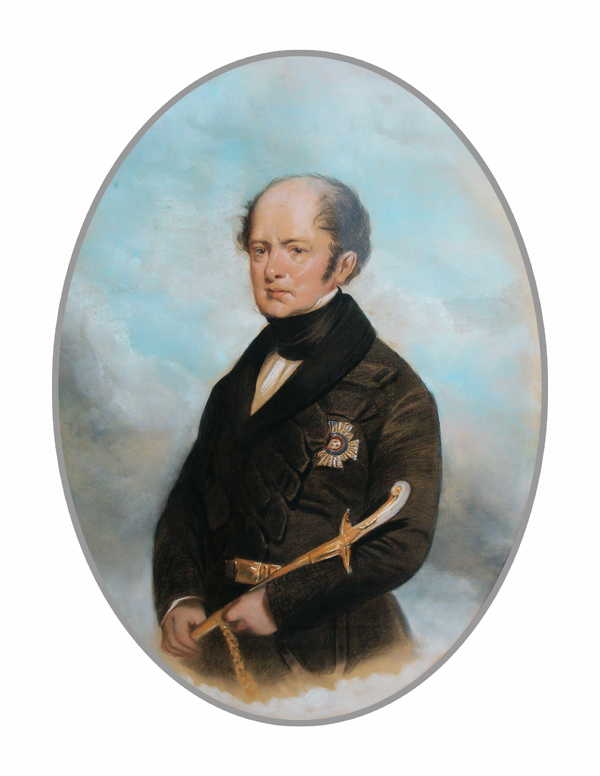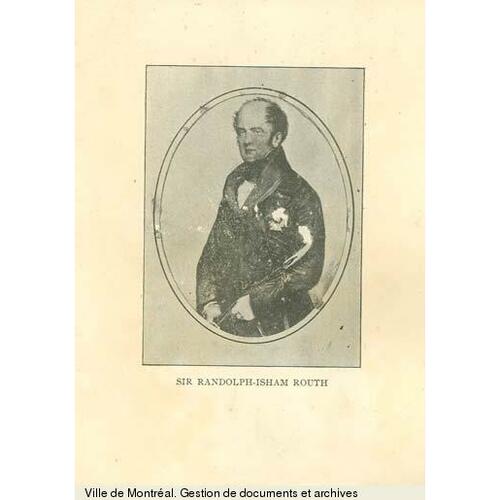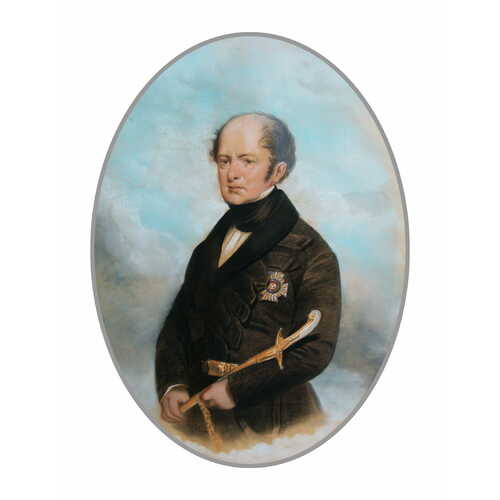
Source: Link
ROUTH, Sir RANDOLPH ISHAM, commissary general and politician; b. 21 Dec. 1782 in Poole, Dorset, England, third son of Richard Routh*, later chief justice of Newfoundland, and his wife, Abigail Eppes; d. 29 Nov. 1858 in London.
Although Randolph Isham Routh may have descended from an old Yorkshire family of Routh, near Beverley, his father settled the family in Poole while he travelled to Newfoundland each year to fulfil the obligations of his post as collector of customs. Randolph Isham studied at Eton College from 1796 to 1803 and entered the commissariat in 1805. Stationed first at Jamaica, he then served in the Netherlands during the Walcheren campaign of 1809 and throughout the Peninsular War, becoming deputy commissary general in 1812 and senior commissariat officer at Waterloo in 1815. From 1816 to 1822 he served at Malta and for the next four years was senior officer in the West Indies. Promoted to the highest office in the commissariat service in August 1826, Routh was sent to the Canadas where he remained for the next 17 years.
When Routh arrived at Quebec in 1826, he was in charge of all the financial transactions of the army in the Canadas and was guardian of a military chest with resources often equalling or exceeding those of Lower Canada’s provincial treasury. One of his most persistent, though unsuccessful, endeavours was to try to influence the House of Assembly of Lower Canada to adopt British sterling as the official medium of exchange and thus eliminate the confusion resulting from the use of a variety of foreign currencies.
Routh was more effective in his vigorous protest against the proposal in the early 1830s to turn all the financial business of the military over to local banks. In a 17-page report submitted to the British Treasury, he pointed out that the Bank of Montreal was the only colonial bank stable enough to undertake such a commitment, but he argued against this move on the grounds that the directors of the bank would then become the “real capitalists of the country at little personal risk.” He also believed that both the efficiency and the secrecy of troop movements would be jeopardized if the commissariat could not act independently of local banks. In 1838 Routh added his protest to that of the commander of the forces, Sir John Colborne*, against the recommendation by Sir George Arthur, lieutenant governor of Upper Canada, to have a separate commissariat establishment in that province. Routh’s service in British North America included the years of the rebellions of 1837–38, when his department was suddenly faced with wartime conditions and criticized by regimental officers in the field. Lieutenant-Colonel George Cathcart commented that Routh had no notion of organizing a field commissariat and that nothing could have been more complicated or less efficient than his arrangements. Cathcart admitted that part of the confusion arose from Colborne’s initial orders at the outbreak of the second rebellion in 1838 to have the troops live at free quarters, which led to plunder by them in the disturbed areas. None the less, Routh was appointed to the Executive Council by Lord Durham [Lambton*] and held office from 2 June 1838 to 10 Feb. 1841.
Routh married first, probably on 26 Dec. 1815, at Paris, Adélaïde-Marie-Joséphine Lamy (Laminière), granddaughter of the secretary general of the Gardes de Corps of Louis XVI. She died at Quebec in 1827. The couple had had five children, of whom Randolph, the eldest son, eventually became commissary general. By 1829 Routh was courting Marie-Louise Taschereau, daughter of Jean-Thomas Taschereau* and sister of the future cardinal Elzéar-Alexandre Taschereau*; he was approximately 30 years her senior. Louis-Joseph Papineau*, after attending one of the numerous balls at Routh’s residence, wrote to his wife: “I spoke at length with Madame [Marie] Taschereau about the widower’s merits, his manners, his interest in uniting the two societies, English and French Canadian. The good mother spoke more favourably of his qualities than I and convinced me, inadvertently, that her opposition was designed to obtain better terms for her daughter.” The couple were married on 16 Jan. 1830 in the church of the British garrison at Quebec. There were four sons and five daughters of this marriage and his expanding family probably explains Routh’s eagerness to buy some 6,599 acres of land along the Rivière Etchemin in the townships of Ware, Cranbourne, and Standon, south of Quebec, a purchase completed some time before 1836.
Knighted in 1841, partly for his long service in the Canadas, Routh returned to England in January 1843 on half pay. At this time he wrote Observations on the commissariat field service and home defences, which remained the standard work on the commissariat for many years. From 1845 to 1848 he superintended the distribution of relief in Ireland during the famine, a situation in which he faced unparalleled emergency conditions as a result of successive potato crop failures. When first consulted about the secret purchase of some £100,000 of Indian corn in the United States for relief in Ireland, Routh suggested that one of his Taschereau relatives in Quebec could see to the business discreetly, but the Treasury preferred to let the firm of Baring Brothers undertake the purchase. Routh tried to limit the distribution of corn to the absolutely destitute and in 1847 he unsuccessfully urged that the export of higher-priced grains be prohibited when he became convinced that it was not resulting in an increase in the import of lower-priced food. For his work in Ireland he was created a kcb on 27 April 1848.
Routh’s services, not only in the Canadas and Ireland but in the West Indies as well, drew acclaim for the efficiency with which he ran the commissariat operations, the skill with which he cleansed the department of jobbery by eliminating close associations between commissariat officers and contractors, and, above all, his emphasis on proper bookkeeping and auditing of accounts. None challenged his integrity in running the commissariat. Yet he had an eye for lucrative financial transactions outside the department, thus giving military colleagues an opportunity to observe privately and correctly that, “though a good servant to the treasury . . . [he] made his own fortune [in the Canadas] notwithstanding.” It was Routh who restored to the commissariat officers their distinctive uniform with epaulettes. A contemporary observed that under the “calm, cautious and carefully reserved” Routh, the “Commissariat was subdued, sobered and raised in the most quiet manner.”
Sir Randolph Isham Routh is the author of Observations on the commissariat field service and home defences, originally issued in 1845; a second edition was published in London in 1852.
ANQ-Q, CE1-71, 16 janv. 1830. Arch. du monastère des ursulines (Québec), Annales, II: 65, 67; XI: 62–63. PAC, MG 30, D1, 26: 650; RG 8, I (C ser.), 79: 107–13, 121–38; 1274: 162–67. PRO, T 1/8274 (copy at PAC); WO 17/1547: 201. Gentleman’s Magazine, January–June 1859: 92–93. Minutes of evidence taken under the direction of a general commission of enquiry, for crown lands and emigration, appointed on the 21st June, 1838, by His Excellency the Right Honorable the Earl of Durham, high commissioner, and governor general of her majesty’s colonies in North America (Quebec, 1839). Appleton’s cyclopædia of American biography, ed. J. G. Wilson et al. (10v., New York, 1887–1924), 5: 336–37. Boase, Modern English biog., 3: 319–20. Borthwick, Hist. and biog. gazetteer. Desjardins, Guide parl. DNB. G.B., WO, Army list, 1838. Morgan, Sketches of celebrated Canadians. Prowse, Hist. of Nfld. (Thoms and Gill; 1971). P.-G. Roy, Les cimetières de Québec (Lévis, Qué., 1941); La famille Taschereau (Lévis, 1901). C. B. F. G. Woodham Smith, The great hunger, Ireland, 1845–1849 (New York, 1922). J.-J. Lefebvre, “La vie sociale du grand Papineau,” RHAF, 11 (1957–58): 463–516.
Cite This Article
Elinor Kyte Senior, “ROUTH, Sir RANDOLPH ISHAM,” in Dictionary of Canadian Biography, vol. 8, University of Toronto/Université Laval, 2003–, accessed December 31, 2025, https://www.biographi.ca/en/bio/routh_randolph_isham_8E.html.
The citation above shows the format for footnotes and endnotes according to the Chicago manual of style (16th edition). Information to be used in other citation formats:
| Permalink: | https://www.biographi.ca/en/bio/routh_randolph_isham_8E.html |
| Author of Article: | Elinor Kyte Senior |
| Title of Article: | ROUTH, Sir RANDOLPH ISHAM |
| Publication Name: | Dictionary of Canadian Biography, vol. 8 |
| Publisher: | University of Toronto/Université Laval |
| Year of publication: | 1985 |
| Year of revision: | 1985 |
| Access Date: | December 31, 2025 |




